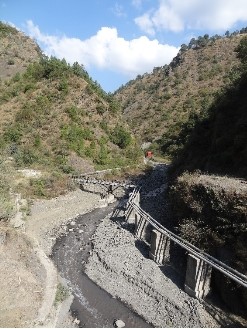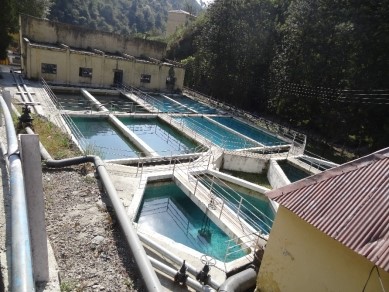Shimla, India’s water crisis: From source to sewer
Shimla, India’s water crisis: From source to sewer
The residents of the northern Indian resort town of Shimla are suffering from water shortages and pollution. Now climate change is compounding these woes, reports the Gorakhpur Environmental Action Group (GEAG).
The northern Indian hill city of Shimla is marked with lush green hills, covered with its striking tall pine and deodar forests in summers - a stark contrast to the fantastic snow slopes in winters. In the past, the city was alluring, thanks to its well-designed infrastructure. It was originally built as a home and summer residence of viceroys and governor-generals of India. The city was built around 1875 as the summer capital of British India and catered to a population of 16,000.
Its water supply was around 4.54 million litres of water a day (MLD). By 2005, the city had augmented its water supply to 22 MLD, but by then, the demand had reached 24 MLD. The city’s resident population is about 2 lakh (200,000) residents today. An additional 75,000 tourists visit each year in search of a quiet moment of solitude.
The city has been witnessing an acute shortage of water, with its taps running dry for days during the peak tourist season. There have been frantic scrambles at the back of water tankers in response to brief windows of piped supplies for the residents - so much so that residents pled with tourists on social media to stay away in 2019. Such was the crisis that the Himachal Pradesh High Court got involved – ordering that water supplies should be used wisely for the common good and not siphoned off by VIPs.
 The plight of the city is an extreme example of problems that experts have long been warning about: water scarcity and contamination. Just four years ago, the city witnessed an ordeal when it experienced a major water contamination episode leading to a hepatitis outbreak.
The plight of the city is an extreme example of problems that experts have long been warning about: water scarcity and contamination. Just four years ago, the city witnessed an ordeal when it experienced a major water contamination episode leading to a hepatitis outbreak.
Shimla’s natural ecosystem - sprawling across its peri-urban stretches and its urban forests - acts as an environmental buffer for the city, absorbing storm water, improving air quality and contributing to its water supply. The area adjoining the city is dotted by myriad spring-fed streams and rivers without which the city would not be able to draw its sustenance.
Originating from its forests and hills and coursing through the peri-urban stretches, these water sources form an intricate web that is the backbone of Shimla’s perennial water supply. The city boosts of around seven water sources, all of which witnessed significant reduction in their water availability over time.
Over the years, as the population grew with little or no augmentation to the water supply, Shimla’s water supply deficit increased substantially, leaving its residents in the lurch.
The fragile water supply system in the peri-urban areas has been increasingly affected by rapid construction: forests have been cut to make space for buildings, including for hotels to boost tourism. The cutting down of forests for ‘development’ affects the percolation of water through the ground, drying up the water channels that feed the streams.
River catchments are being destroyed and the hydrology of the region disturbed in the absence of proper peri-urban planning and by people’s ignoring laws and regulations. In addition, climate change impacts have been quite significant in hilly habitations like Shimla, which are dependent on water supply systems from streams originating in the high hills. The warming climate is associated with lower quantities of water flows from the high hills to the downstream areas. The low volume of fresh water is also vulnerable to contamination due to the pollution load - resulting in increased concentrations of contaminants, such as viral hazards which cause diseases like jaundice.
Poor institutional coordination led to public health havoc in 2016
The state’s water sources are managed by the Irrigation and Public Health department, which looks after bulk supply and treatment of water. The distribution, pumping, metering and billing of potable water is under the Shimla Municipal Corporation (SMC). The agencies have been bamboozled by the city’s growth and are struggling to manage its water and sewage systems. To make matters worse, the coordination between these two agencies as well as with others is very weak.
When the city's antiquated plumbing received an urgent upheaval in 2005, three sewage treatment plants were set up. All three of them were located upstream of the Ashwani Khad, a water source established in 1995. None of these sewage treatment plants functioned, and to make matters worse, the sludge from the broken-down plant at Malyana contaminated the Ashwani Khad water source in 2015-16. This is particularly worrying, as the health experts and virologists had cautioned the city authorities about the possibility of a hepatitis outbreak. Yet, the Irrigation and Public Health department ignored the warnings on sewage contamination and held no discussions with the Shimla Municipal Corporation.
The residents complained of poor quality of water and every winter saw an outbreak of hepatitis. In 2016, the untreated sewage from the dysfunctional sewage treatment plants found its way into the water source and the city reported 1,620 jaundice cases and 9 deaths. Unofficial estimates put the number of infected at over 10,000 as sewage-laden water flowed out of this city's taps. The Municipal Corporation was caught unawares as the bracing cold aided the spread of hepatitis virus due to low dissolution of sewage in the streams.
Overhauling Shimla’s water sector: Policy and institutional reforms
 Learning from the water contamination crisis, major reforms were undertaken in Shimla. To manage its water supply and sewerage services, the state government set up a dedicated utility - Shimla Jal Prabandhan Nigam Ltd (SJPNL) jointly with the Shimla Municipal Corporation. Earlier, these responsibilities were fragmented among different agencies and departments, leading to blurred accountability and poor coordination.
Learning from the water contamination crisis, major reforms were undertaken in Shimla. To manage its water supply and sewerage services, the state government set up a dedicated utility - Shimla Jal Prabandhan Nigam Ltd (SJPNL) jointly with the Shimla Municipal Corporation. Earlier, these responsibilities were fragmented among different agencies and departments, leading to blurred accountability and poor coordination.
Policy decisions such as setting water tariffs and subsidies are taken by the state government and the city municipality. The World Bank is supporting the Government of Himachal Pradesh’s programme of policy and institutional reforms in (i) bringing bulk water to Shimla from a new source on the Sutlej river after the closure of Ashwani Khad; (ii) 24 x 7 water supply and sewage management for Shimla city; and (iii) sewage services for peri-urban areas.
The current reforms in the policy and institutional structures have led to a multi-pronged response to the city’s water crisis. The city is able to meet its water demand and the water supply has been extended in the peri-urban areas up to 300 metres on the city’s periphery. The water quality monitoring system established at the SJPNL ensures water testing at three levels.
The fetching and supplying of good quality water for its inhabitants comes at a very high cost. More so now, as supply from Ashwani Khad is closed and the Shimla Municipal Corporation replaced 2,000 metre-long pipes from the Giri drinking water scheme. The pumps for lifting water at the Gumma scheme were also repaired. SJPNL has taken steps to improve water quantity and quality by replacing leaking bulk water pipes, upgrading old pumps, expanding the number of daily water samples taken for testing, and increasing the volume of sewage collection.
The paradigm shift in the water supply sector in Shimla can be attributed to the much needed policy and institutional reforms. These include accountability to citizens, cost recovery, tariff structures devised as per the local situation and a subsidy policy for which the government is accountable. It also entails a strong institutional structure, which includes a powerful Board of Directors and professional staff.
The big picture
Shimla and many other cities in India do not exist in silos and are dependent on their peri-urban areas for supply of food, water, goods and services. The unfettered growth of cities like Shimla beyond their carrying capacities has compromised the ecological and livelihood security of the peri-urban communities. This is putting forth new challenges for urban and peri-urban water governance.
The urban peri-urban connection and the related governance mechanisms are very crucial for the resilience of cities and their periurban areas. Urban-periurban governance becomes very important for the provision of adequate and safe water supply to the cities. The combination of measures taken up in Shimla appears to have averted a water armageddon - for now, at least - from water contamination. The SJPNL is also analysing the seasonal variations in snowfall, temperature and so on and the Standard Operating Procedures (SOPs) for water management are being formulated accordingly.
Still, more needs to be done in terms of public or state engagement with periurban issues. Civil society organisations need to play a key role in lobbying to draw the attention of the state to practical solutions that can ameliorate ecological stresses. The citizenry can take up the onerous task of making sure state agencies do not slip back into their old habits.
This blog has been written by GEAG as part of the Knowledge Brokering Project on Peri-Urban Ecosystems for Urban Climate Change Resilience: Addressing Knowledge and Capacity Gaps, supported by CDKN.
